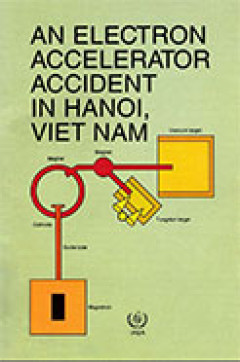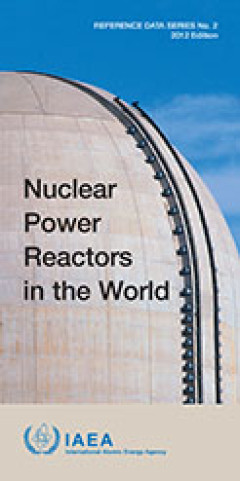Ditapis dengan

Concepts of Modern Physics, Sixth Edition
Modern Physics is the most up-to-date, accessible presentation of modern physics available. The book is intended to be used in a one-semester course covering modern physics for students who have already had basic physics and calculus courses. The balance of the book leans more toward ideas than toward experimental methods and practical applications because the beginning student is better served…
- Edisi
- 7th edition
- ISBN/ISSN
- 007-244848-2
- Deskripsi Fisik
- xiii, 542p. :ill.; 26cm
- Judul Seri
- -
- No. Panggil
- 530 Gei c

Health Surveillance of Persons Occupationally Exposed to Ionizing Radiation: …
This Safety Report specifies features of work under radiation conditions, the general rules of radiological protection for occupational exposure and the organization of the medical surveillance of workers occupationally exposed to radiation. It supersedes IAEA Safety Series No. 83, Radiation Protection in Occupational Health: Manual for Occupational Physicians (1987).
- Edisi
- -
- ISBN/ISSN
- -
- Deskripsi Fisik
- -
- Judul Seri
- Safety Reports Series No. 5
- No. Panggil
- 594.12

An Electron Accelerator Accident in Hanoi, Viet Nam
n 17 November 1992 a radiological accident occurred at an electron accelerator facility in Hanoi, Viet Nam. An individual entered the irradiation room without the operators' knowledge and unwittingly exposed his hands to the X ray beam. His hands were seriously injured and one hand had to be amputated. The report details the circumstances of the accident, its medical consequences and the govern…
- Edisi
- -
- ISBN/ISSN
- 9201004966
- Deskripsi Fisik
- 36 p. : Illus. ; 24 cm
- Judul Seri
- -
- No. Panggil
- 537.5 IAE a

Regulations for the Safe Transport of Radioactive Material, 1985 Edition (As …
This book contain of seven section: Section I. Introduction; Section II. General provisions; Section III. Activity and fissile material limits; Section IV. Preparation, requirements and controls for shipment and for storage in transit; Section V. Requirements for radioactive materials and for packagings and packages; Section VI. Test procedures; and Section VII. Approval and administrative requ…
- Edisi
- -
- ISBN/ISSN
- 9201238908 / 00741892
- Deskripsi Fisik
- 112 p. : Illus. ; 24 cm
- Judul Seri
- Safety Series No. 6
- No. Panggil
- 539.7 IAE r

Nuclear Power Reactors in the World
This is the 32nd edition of Reference Data Series No. 2, which presents the most recent reactor data available to the IAEA. It contains summarized information as of the end of 2011 on power reactors that are in operation, under construction and shut down, and performance data on reactors operating in IAEA Member States, as reported to the IAEA. The information is collected through designated na…
- Edisi
- 2012
- ISBN/ISSN
- 9789201323101
- Deskripsi Fisik
- -
- Judul Seri
- -
- No. Panggil
- 539 IAE n

Preparation of Environmental Reports for Nuclear Power Stations
The U.S. Nuclear Regulatory Commission (NRC) is issuing Revision 3 of Regulatory Guide (RG) 4.2, “Preparation of Environmental Reports for Nuclear Power Stations.” This revision provides general guidance to applicants for the format and content of environmental reports (ERs) that are submitted as part of an application for a permit, license, or other approval for a new nuclear power plant.
- Edisi
- -
- ISBN/ISSN
- -
- Deskripsi Fisik
- -
- Judul Seri
- NUREG-0099 Regulatory Guide 4.2 Revision 2
- No. Panggil
- 539.7 NUR p

Principles for the Exemption of Radiation Sources and Practices from Regulato…
The need for a consistent international approach to exclusion and exemption of radiation sources and practices from regulatory control has become increasingly evident, especially for sources which may be transported from one country to another, such as consumer products containing very small amounts of radioactive material. This safety guide represents a first international consensus on the sub…
- Edisi
- -
- ISBN/ISSN
- 9201238886 / 00741892
- Deskripsi Fisik
- 23 p. : Illus. ; 24 cm
- Judul Seri
- Safety Series No. 89
- No. Panggil
- 539.7 IAE p

College Physics
College Physics, Fourth presents a unique forces first approach to physics that builds a conceptual framework as motivation for the physical principles. That intuitive approach, combined with a consistent problem solving strategies, stunning art, extensive end-of-chapter material, and superior media support make Giambattista, Richardson, and Richardson a product that addresses the needs of TODA…
- Edisi
- -
- ISBN/ISSN
- 0071214623
- Deskripsi Fisik
- 1165 p. : Illus. ; 27 cm
- Judul Seri
- -
- No. Panggil
- 530 GIA c

GUIDEBOOK ON DESIGN, CONSTRUCTION AND OPERATION OF PILOT PLANTS FOR URANIUM O…
-
- Edisi
- -
- ISBN/ISSN
- 920145290X / 00741914
- Deskripsi Fisik
- 98 p : Illus. ; 21 cm
- Judul Seri
- Technical Reports Series No. 314
- No. Panggil
- 539.2 PRO r

Environmental Impact Assessment of Recycled Wastes on Surface and Ground Wate…
The state of the art of the impact assessment of recycled hazardous waste materials on surface and ground waters is presented. The topics include chemodynamics, toxicology, modeling and information systems. Due to the wealth of information on this topic, the texts of T. Kassim (ed.): Environmental Impact Assessment of Recycled Wastes on Surface and Ground Waters are published in three separa…
- Edisi
- Volume 2
- ISBN/ISSN
- 9783540235876 / 14336863
- Deskripsi Fisik
- xvii, 283 p. : Illus. ; 24 cm
- Judul Seri
- -
- No. Panggil
- 551 KAS e
 Karya Umum
Karya Umum  Filsafat
Filsafat  Agama
Agama  Ilmu-ilmu Sosial
Ilmu-ilmu Sosial  Bahasa
Bahasa  Ilmu-ilmu Murni
Ilmu-ilmu Murni  Ilmu-ilmu Terapan
Ilmu-ilmu Terapan  Kesenian, Hiburan, dan Olahraga
Kesenian, Hiburan, dan Olahraga  Kesusastraan
Kesusastraan  Geografi dan Sejarah
Geografi dan Sejarah